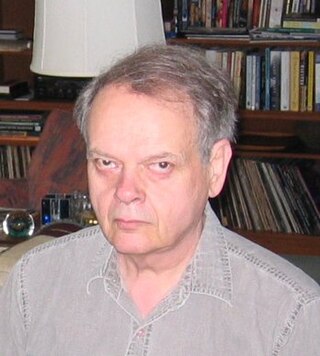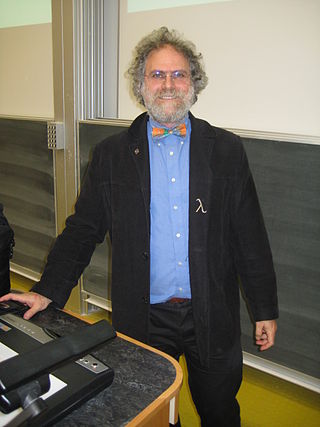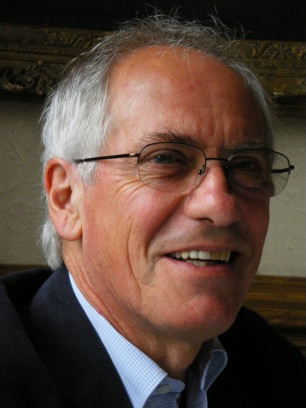
The Z notation is a formal specification language used for describing and modelling computing systems. It is targeted at the clear specification of computer programs and computer-based systems in general.

Sir Charles Antony Richard Hoare also known as Tony Hoare or by his initials C. A. R. Hoare is a British computer scientist who has made foundational contributions to programming languages, algorithms, operating systems, formal verification, and concurrent computing. His work earned him the Turing Award, usually regarded as the highest distinction in computer science, in 1980.

Johns Frederick (Jeff) Rulifson is an American computer scientist.

The von Neumann architecture—also known as the von Neumann model or Princeton architecture—is a computer architecture based on a 1945 description by John von Neumann, and by others, in the First Draft of a Report on the EDVAC. The document describes a design architecture for an electronic digital computer with these components:

The Department of Computer Science and Technology, formerly the Computer Laboratory, is the computer science department of the University of Cambridge. As of 2023 it employed 56 faculty members, 45 support staff, 105 research staff, and about 205 research students. The current Head of Department is Professor Alastair Beresford.

The School of Informatics is an academic unit of the University of Edinburgh, in Scotland, responsible for research, teaching, outreach and commercialisation in informatics. It was created in 1998 from the former department of artificial intelligence, the Centre for Cognitive Science and the department of computer science, along with the Artificial Intelligence Applications Institute (AIAI) and the Human Communication Research Centre.

High-performance computing (HPC) uses supercomputers and computer clusters to solve advanced computation problems.

Christopher S. Strachey was a British computer scientist. He was one of the founders of denotational semantics, and a pioneer in programming language design and computer time-sharing. He has also been credited as possibly being the first developer of a video game and for coining terms such as polymorphism and referential transparency that are still widely used by developers today. He was a member of the Strachey family, prominent in government, arts, administration, and academia.
Hope is a small functional programming language developed in the 1970s at the University of Edinburgh. It predates Miranda and Haskell and is contemporaneous with ML, also developed at the University. Hope was derived from NPL, a simple functional language developed by Rod Burstall and John Darlington in their work on program transformation. NPL and Hope are notable for being the first languages with call-by-pattern evaluation and algebraic data types.

James Quentin Stafford-Fraser is a computer scientist and entrepreneur based in Cambridge, England. He was one of the team that created the first webcam, the Trojan room coffee pot. Quentin pointed a camera at the coffee pot and wrote the XCoffee client program which allowed the image of the pot to be displayed on a workstation screen. When web browsers gained the ability to display images, the system was modified to make the coffee pot images available over HTTP and thus became the first webcam.

The Department of Computer Science is the computer science department of the University of Oxford, England, which is part of the university's Mathematical, Physical and Life Sciences Division. It was founded in 1957 as the Computing Laboratory. By 2014 the staff count was 52 members of academic staff and over 80 research staff. The 2019, 2020 and 2021 Times World University Subject Rankings places Oxford University 1st in the world for Computer Science. Oxford University is also the top university for computer science in the UK and Europe according to Business Insider. The 2020 QS University Subject Rankings places The University of Oxford 5th in the world for Computer Science.

John Charles Reynolds was an American computer scientist.

Philip Lee Wadler is a UK-based American computer scientist known for his contributions to programming language design and type theory. He is holds the position of Personal Chair of theoretical computer science at the Laboratory for Foundations of Computer Science at the School of Informatics, University of Edinburgh. He has contributed to the theory behind functional programming and the use of monads; and the designs of the purely functional language Haskell and the XQuery declarative query language. In 1984, he created the Orwell language. Wadler was involved in adding generic types to Java 5.0. He is also author of "Theorems for free!", a paper that gave rise to much research on functional language optimization.

Richard Simpson Bird was an English computer scientist.

Programming language theory (PLT) is a branch of computer science that deals with the design, implementation, analysis, characterization, and classification of formal languages known as programming languages. Programming language theory is closely related to other fields including mathematics, software engineering, and linguistics. There are a number of academic conferences and journals in the area.
Bluespec, Inc. is an American semiconductor device electronic design automation company based in Framingham, Massachusetts, and co-founded in June 2003 by computer scientists Arvind Mithal, professor of the Massachusetts Institute of Technology (MIT), and Joe Stoy of Oxford University. Arvind had formerly founded Sandburst in 2000, which specialized in producing chips for 10 Gigabit Ethernet (10GE) routers, for this task.
Rodney Martineau "Rod" Burstall is a British computer scientist and one of four founders of the Laboratory for Foundations of Computer Science at the University of Edinburgh.
Arvind Mithal, known mononymously as Arvind, was an Indian computer scientist, the Johnson Professor of Computer Science and Engineering in the Computer Science and Artificial Intelligence Laboratory (CSAIL) at the Massachusetts Institute of Technology (MIT). He was a Fellow of the Institute of Electrical and Electronics Engineers (IEEE) and the Association for Computing Machinery (ACM). He was also elected as a member into the National Academy of Engineering in 2008 for contributions to dataflow and multithread computing and the development of tools for the high-level synthesis of digital electronics hardware.

Carl Eddie Hewitt was an American computer scientist who designed the Planner programming language for automated planning and the actor model of concurrent computation, which have been influential in the development of logic, functional and object-oriented programming. Planner was the first programming language based on procedural plans invoked using pattern-directed invocation from assertions and goals. The actor model influenced the development of the Scheme programming language, the π-calculus, and served as an inspiration for several other programming languages.
Haskell is a general-purpose, statically-typed, purely functional programming language with type inference and lazy evaluation. Designed for teaching, research, and industrial applications, Haskell has pioneered several programming language features such as type classes, which enable type-safe operator overloading, and monadic input/output (IO). It is named after logician Haskell Curry. Haskell's main implementation is the Glasgow Haskell Compiler (GHC).













